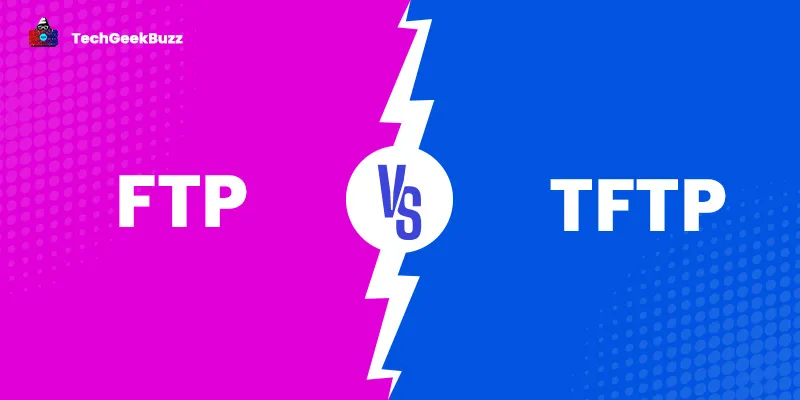In this digital era, transferring files over the internet is one of the most common tasks. Today, there are various protocols that facilitate the transfer of files between two remote computer systems over the TCP/IP network.
Among all, FTP and TFTP are two common file transfer protocols. They are the application layer protocols in the TCP/IP model that transfer files from the client to the server and vice-versa.
FTP stands for File Transfer Protocol, while TFTP stands for Trivial File Transfer Protocol. TFTP is a simplified alternative to FTP. Both these protocols transfer files between systems in plain text and are considered insecure. Therefore, FTP and TFTP are ideal for sharing only non-sensitive information over an unsecured public network.
However, there is a secure alternative to FTP and TFTP file transfer protocols called Secure File Transfer Protocol (SFTP). This protocol runs on the Secure Shell (SSH) protocol and is more secure and reliable than FTP and TFTP.
This blog post will help you gain insights into the differences between FTP and TFTP so that you can choose the appropriate protocol that meets your organization’s needs. Also, you will learn about FTP and TFTP, along with their benefits and drawbacks.
So, let us get started!
What is FTP?
FTP stands for File Transfer Protocol. It is a network protocol that enables the transmission of computer files between remote computer systems over a TCP/IP network. It follows a client-server architecture , which establishes two separate connections for data and control between the client and the server.
Any FTP transaction involves two remote computer systems or devices. The end user's computer system is typically a local host. On the other hand, the second computer system or device involved is the remote host, more specifically, the server.
To enable file transfer between local and remote hosts, they must be connected through a network and configured properly. In addition, it is essential to set up the server to run the FTP services, and the client computer must have FTP software installed to access those services.
How Does FTP Work?
Since FTP is a client-server protocol, it uses two different connections simultaneously, namely the data connection and the control connection. It leverages the control connection to transfer control information, such as user identification, password, and commands to store and retrieve files and change the remote directory. On the other hand, FTP uses the data connection to transfer the actual file. '
In an FTP session, the client initiates the TCP connection to the server and transmits control information over that connection. On receiving the control information, the server initiates the data connection to the client. However, it is important to note that one data connection supports the transfer of only one file. Also, the control remains active throughout the FTP session.
Features of FTP
The following are the basic features of FTP:
- Data Representation: FTP supports three types of data representation, namely ASCII (7-bit), binary data (8-bit), and EBCDIC (8-bit). The default file format to transfer files in FTP is the ASCII file. Moreover, the image file is the default file format for transferring binary files.
- File Organization: FTP supports structured as well as unstructured files. A structured file consists of a list of records, where each record is delimited by EOR (End of Record). On the other hand, an unstructured file consists of a string of bytes, and this file is delimited by EOF (End of File).
- Data Structure: The data structure corresponding to an unstructured file is called file structure. On the flip side, the data structure corresponding to a structured file is called record structure.
- Transmission Modes: FTP supports three different transmission modes, namely stream mode, block mode, and compressed mode.
- Error Control: Since FTP follows the TCP protocol for communication, it does not require any other error recovery mechanism.
- Access Control: FTP provides file access control through the login procedure with username and password.
Advantages of FTP
Here are some remarkable benefits of FTP:
- FTP is one of the fastest communication protocols to transfer files between remote computer systems.
- It enables the host to transfer two or more files simultaneously, along with multiple directories, to another host.
- There is nothing to worry about even if you lose the connection while transferring files between computer systems. FTP enables you to resume the file transfer where you left it.
- You can schedule the file or directory transfer.
- FTP provides an automatic backup feature. Therefore, you will not lose your data in case of any unexpected events.
Disadvantages of FTP
Some significant downsides of FTP are as given below:
- FTP transmits data in plain text. Also, it transmits the usernames and passwords in plain text, which results in unwanted eavesdropping. Malicious hackers can easily perform brute force attacks to determine passwords.
- It does not support multiple receivers.
- The maximum file size that can be transferred is limited to 2 GB.
- Not all FTP providers offer the data encryption service.
What is TFTP?
TFTP is an acronym for Trivial File Transfer Protocol. It is a simple lockstep file transfer protocol that enables the transfer of files between computer systems in a local network. It is a simple protocol that leverages the User Datagram Protocol (UDP) to transfer files between computer systems on the internet.
Trivial File Transfer Protocol has a simple design and limited features compared to FTP. In addition, it provides user authentication while transferring files. It also does not provide any security mechanism while transferring files over a network.
Therefore, the primary application of TFTP is to transfer boot files or configuration files between different systems set up in a local intranet.
Additionally, this protocol is beneficial when the client’s system has low memory storage devices or hard disk devices.
How Does TFTP Work?
Trivial File Transfer Protocol uses the User Datagram Protocol for transferring files. Therefore, this protocol initiates a connection by using port 69.
After the connection establishes, the client sends the Read Request (RRQ) to only read a particular file or the Write Request (WRQ) to write the file to the server. The server receives the request, divides the file into small packets, and transmits them to the client one by one. The size of each packet is 512 bytes.
Furthermore, the server waits for the acknowledgment from the client that it has received the packet. Upon receiving the acknowledgment, the server sends the next packet, and the process continues till the last packet.
Features of TFTP
The salient features of TFTP are as follows:
- TFTP works on the client-server principle that uses the User Datagram Protocol (UDP) for file transfer.
- It leverages the well-known UDP port number 69 for the TFTP server.
- TFTP is not secure and does not support user authentication.
- Each data unit in TFTP has a sequence number.
- The client machine sends the acknowledgment for every data unit or packet. When the server receives the acknowledgment from the client, it transmits the next data packet or unit.
Advantages of TFTP
Some notable benefits of TFTP are listed below:
- TFTP has a simple design and is easy to implement.
- This protocol does not require the client machine to have high memory storage devices.
- It is ideal for fast file transfers.
- TFTP enables reading and writing files without the need to establish a connection between the client and the server.
Disadvantages of TFTP
The following are the major drawbacks of TFTP:
- TFTP does not provide a user authentication mechanism.
- It does not offer a security mechanism.
- There is no data encryption in TFTP.
FTP vs TFTP: A Head-to-Head Comparison
The following table draws a detailed comparison between FTP and TFTP:
| Parameters | FTP | TFTP |
| Full Form | FTP stands for File Transfer Protocol. | The full form of TFTP is Trivial File Transfer Protocol. |
| Connectivity Protocols | It uses TCP to transfer files between two remote hosts on a network. Meaning that it establishes a connection between the client and the server. | It uses UDP to transfer files between two different systems in a local network. There is no need for the establishment of a connection between two systems. |
| Port Number | FTP works on port numbers 20 and 21. | TFTP works on port number 69. |
| Complexity | FTP is more complex than TFTP. | TFTP has a simple design and is less complex as compared to FTP. |
| Authentication | This protocol requires user authentication before transferring files. | This protocol does not include user authentication for file transfer. |
| Commands | FTP supports a wide range of commands, including get, put, ls, dir, mkdir , rmdir, delete, help, and close. | TFTP supports only five commands, namely Reading Request (RRQ), Write Request (WRQ), Data (DATA), Acknowledgment (ACK), and Error (ERROR). |
| Reliability | It is highly reliable. | This transfer protocol is not as reliable as TFTP. |
| Memory Requirement | FTP requires more memory than TFTP. | TFTP requires less memory. |
| Speed | FTP is slower than TFTP. | TFTP is faster than FTP. |
| Usage | It is ideal for uploading and downloading files by remote users. | It is ideal for the transmission of configurations to and from the network devices. |
FTP vs TFTP: Which One to Choose?
FTP and TFTP are protocols that facilitate the transfer of files between computer systems. The primary difference between FTP and TFTP is that FTP enables file transfer between two systems in a wide area network (WAN), while TFTP is used for file transfer between two systems in a local network.
Therefore, choosing TFTP would be a great move when you need to transfer files locally within a data center, where security and network stability are not of much importance. On the flip side, FTP is an ideal choice when you need to transfer files over a wide area network.
Conclusion
Both FTP and TFTP are insecure file transfer protocols. There are a lot of differences between these two network protocols, as discussed above.
FTP provides user authentication for file transfer, while TFTP does not. In addition, another major difference between FTP and TFTP is that FTP is a connection-oriented service, while TFTP is a connectionless service. However, TFTP is fast and has a simple design compared to FTP.
We recommend you choose between FTP and TFTP based on your organization’s needs and use cases. You can also opt for the most secure transfer protocol called SFTP (Secure File Transfer Protocol) when security is of the utmost importance.
Frequently Asked Questions
1. What is SFTP?
SFTP stands for Secure File Transfer Protocol. It is the most secure file transfer protocol that leverages secure shell encryption to provide high-level security for transferring files over the network. It works on the SSH (Secure Shell) protocol and is the secure version of FTP.
2. On what ports do FTP and TFTP work?
FTP works on port numbers 20 and 21, while TFTP works on port number 69.
3. Enumerate the commands that TFTP supports.
TFTP supports five different commands that are as follows:
- Reading Request (RRQ)
- Write Request (WRQ)
- Data (DATA)
- Acknowledgment (ACK)
- Error (ERROR)
People are also reading:



![What is TCP/IP Model? [Definition, Working, & Layers]](/media/new_post_images/TCP_IP_Model.webp)

Leave a Comment on this Post